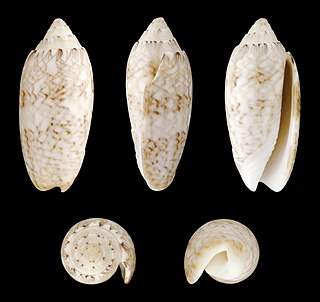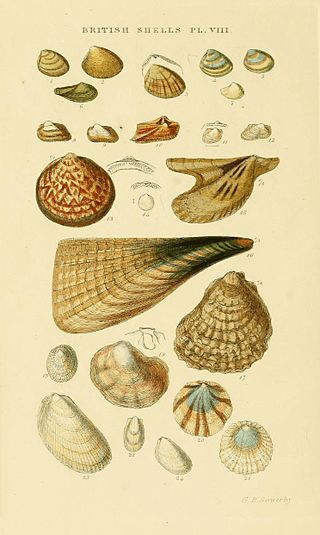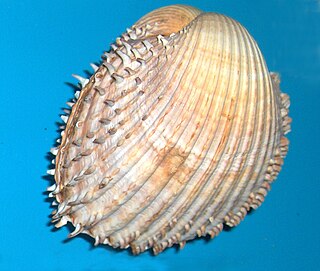
The gastropods, commonly known as slugs and snails, belong to a large taxonomic class of invertebrates within the phylum Mollusca called Gastropoda.

Bivalvia, in previous centuries referred to as the Lamellibranchiata and Pelecypoda, is a class of marine and freshwater molluscs that have laterally compressed bodies enclosed by a shell consisting of two hinged parts. As a group, bivalves have no head and they lack some usual molluscan organs, like the radula and the odontophore. The class includes the clams, oysters, cockles, mussels, scallops, and numerous other families that live in saltwater, as well as a number of families that live in freshwater. The majority are filter feeders. The gills have evolved into ctenidia, specialised organs for feeding and breathing. Most bivalves bury themselves in sediment, where they are relatively safe from predation. Others lie on the sea floor or attach themselves to rocks or other hard surfaces. Some bivalves, such as the scallops and file shells, can swim. The shipworms bore into wood, clay, or stone and live inside these substances.

Scallop is a common name that encompasses various species of marine bivalve mollusks in the taxonomic family Pectinidae, the scallops. However, the common name "scallop" is also sometimes applied to species in other closely related families within the superfamily Pectinoidea, which also includes the thorny oysters.

Scrobicularia plana, the peppery furrow shell, is a bivalve mollusc belonging to the family Semelidae.

The lettered olive, Oliva sayana, is a species of large predatory sea snail, a marine gastropod mollusc in the family Olividae, the olive shells, olive snails, or olives.

The maxima clam, also known as the small giant clam, is a species of bivalve mollusc found throughout the Indo-Pacific region.

The ocean quahog is a species of edible clam, a marine bivalve mollusk in the family Arcticidae. This species is native to the North Atlantic Ocean, and it is harvested commercially as a food source. This species is also known by a number of different common names, including Icelandic cyprine, mahogany clam, mahogany quahog, black quahog, and black clam.

Lajonkairia lajonkairii is an edible species of saltwater clam in the family Veneridae, the Venus clams.

Mollusca is the second-largest phylum of invertebrate animals, after the Arthropoda; members are known as molluscs or mollusks. Around 85,000 extant species of molluscs are recognized. The number of fossil species is estimated between 60,000 and 100,000 additional species. The proportion of undescribed species is very high. Many taxa remain poorly studied.

Mya truncata, common name the blunt gaper or truncate softshell, is a species of edible saltwater clam, a marine bivalve mollusk in the family Myidae.

Juliidae, common name the bivalved gastropods, is a family of minute sea snails, marine gastropod mollusks or micromollusks in the superfamily Oxynooidea, an opisthobranch group.

Donax gouldii, common name the Gould beanclam, is a species of small saltwater clam, a marine bivalve mollusk in the family Donacidae.

Monoplex pilearis, common name the hairy triton, is a species of medium-sized predatory sea snail, a marine gastropod mollusk in the family Cymatiidae.

Musculus niger, or the black mussel, is a species of bivalve mollusc in the family Mytilidae. It can be found in the Atlantic Ocean, eastern Pacific Ocean, and the Arctic Ocean. Along the Atlantic coast of North America, it ranges from the Arctic Ocean to North Carolina.

Limaria pellucida, the Antillean file shell, is a species of bivalve mollusc in the family Limidae. It can be found along the Atlantic coast of North America, ranging from North Carolina to the West Indies.

Acanthocardia is a genus of saltwater clams, marine bivalve molluscs in the family Cardiidae. They are infaunal suspension feeders.

Acanthocardia aculeata, the spiny cockle, is a species of saltwater clams, marine bivalve molluscs in the family Cardiidae. The genus Acanthocardia is present from the Upper Oligocene to the Recent.

Saxidomus gigantea is a large, edible saltwater clam, a marine bivalve mollusk in the family Veneridae, the venus clams. It can be found along the western coast of North America, ranging from the Aleutian Islands to San Francisco Bay. Common names for this clam include butter clam, Washington clam, smooth Washington clam and money shell.

Acanthocardia echinata, the prickly cockle or European prickly cockle, is a species of saltwater clam, marine bivalve molluscs in the family Cardiidae.

Codakia distinguenda, the elegant lucine, is a species of marine bivalve mollusc. It was first described to science in 1872 by George Washington Tryon Jr.




















